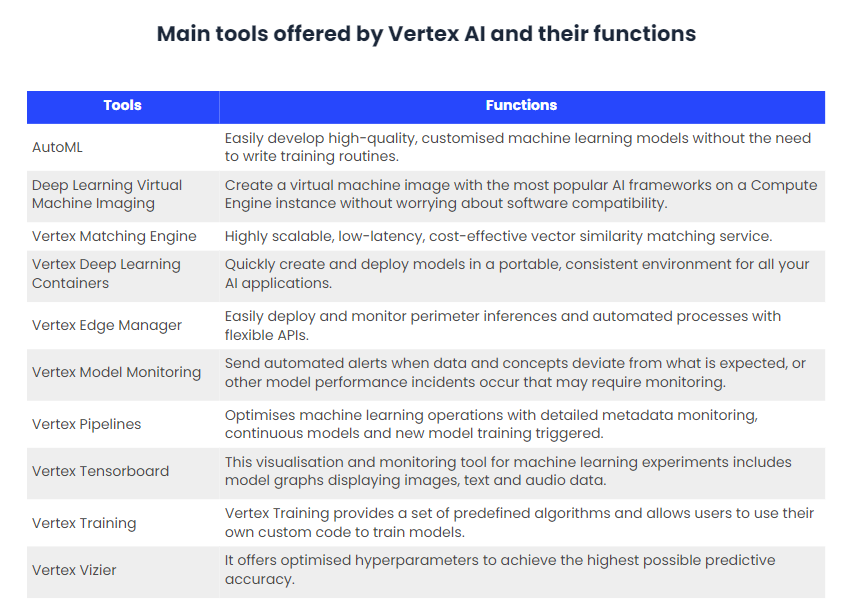The next level of Machine Learning and AI is Vertex AI

Many IT engineers seek to manage images, videos and datasets, creating new machine learning paths to train and evaluate models using algorithms or custom training codes. This enables the deployment of models for online use cases on a scalable, managed infrastructure.
Google Cloud has therefore recently introduced Vertex AI, a managed machine learning platform designed to accelerate the deployment and maintenance of AI models.
This new service provides docker images for developers to execute prediction delivery from models trained with pre-built containers for TensorFlow or XGBoost predictions, among others. In addition, a branch of this platform called Vertex ML Edge Manager can deploy and monitor models at the edge.
Among other features, Google claims that the Vertex AI platform requires fewer lines of code to train a model than other systems. And, in addition, it is powered by the various Google Cloud services. All of this is used to build Machine Learning models. The result is a simpler design and implementation process for models at scale.
Thus, Vertex AI stands out for:
- Create and scale custom machine learning models on a unified artificial intelligence platform.
- Perform development tasks with machine learning tools.
- Deploy more models in less time and reduce the lines of code required to create custom models.
- Employ machine learning operations tools to manage data and models easily and securely.
Features
Vertex AI is characterised by four main features. First, the platform has a unified interface for the Machine Learning workflow. Second, it has pre-trained APIs for different domains. Third, it has full integration of data and AI. And finally, it is compatible with all open source frameworks.
Having a unified interface means creating machine learning models in a single API using Google Cloud services. This makes it easy to train and buy models easily with custom code training. Vertex AI stores all models in a single central repository.
Vertex AI aims to easily integrate Machine Learning models for natural language translation or vision into different existing applications or to create your own intelligent applications.
Also, using BigQuery ML, Vertex AI allows you to create and run machine learning models in BigQuery using standard SQL queries in business intelligence tools and spreadsheets.
Finally, this platform integrates with widely used open source frameworks such as TensorFlow or PyTorch, among others. In addition, it supports all machine learning frameworks through customised training and prediction containers.
Below is a table of some of Vertex AI’s main tools and their functions:

Advantages
One of the benefits of Vertex AI is that it requires very little code, as it makes use of AutoML, as mentioned above, and therefore models can be created quickly. Vertex AI can also be used in conjunction with previously trained APIs in areas such as machine vision, language and structured data.
In addition, the platform has customised tools that enable the creation of advanced Machine Learning models. These tools support advanced programming and require less code for model training, as there is a large repertoire of custom libraries.
Furthermore, the tools used for machine learning eliminate the complex operations of automatic model maintenance or optimise the execution of machine learning processing flows in such a way that they are used to provide different functions.
Finally, the implementation of the models is supported by a service offered by Google for continuous monitoring, allowing to manage the workflows correctly by the teams in the analysis of data for the models. In this way, the models are properly trained, evaluated and deployed in production.
Who has used Vertex AI?
Among the success stories of companies that have used Vertex AI, ModiFace and Essence stand out.
ModiFace belongs to L’Oréal, a leading company in the cosmetics market, and is at the forefront of AI-based augmented reality for the beauty industry. This company, ModiFace, creates new services to test beauty products such as hair colour or make-up virtually in real time.
So, it is using Google’s platform to train its AI models and apply them to its services such as skin diagnosis which is based on thousands of research and innovation images, so that by bringing all this research together with ModiFace’s artificial intelligence algorithm this service allows people to get a skincare routine.
On the other hand, Essence is a data and measurement-driven global media agency that is part of WPP and is extending the value of AI models created by data scientists by integrating their workflows with developers using Vertex AI. Through this change in the way they operate, AI models created by data scientists can be modified once they have been created, adapting to continuous and constant changes in human behaviour and web content. Models can be regularly updated to meet rapidly changing customer and business needs.
Vertex AI gives data scientists the ability to quickly create new models based on the changing environment, while allowing developers and data analysts to maintain models to scale and innovate.
Use cases
Within the use cases, Vertex AI is used for labelling vertex data to enable Machine Learning models to make better predictions. It also enables model tracking and visualisation.
Also, its Vertex Pipelines tool is used to simplify MLOps processes and for managed training services. Predictive accuracy allows for simplifying the process of deploying models in production. This allows developers to obtain detailed model evaluation metrics.
Finally, Vertex ML Edge Manager, which is currently being piloted, facilitates the deployment and seamless monitoring of edge inferences and automated processes with flexible APIs, facilitating AI distribution across the public and private cloud, local and edge devices, among other features.
Conclusions
Until now, when training algorithms, millions of test images, videos or language had to be run. This was the case for ModiFace, which was in charge of developing digital augmented reality and AI services for the beauty industry.
Today, thanks to Verte AI, this whole process can be simplified as it is the platform that does the heavy lifting. This technology has the means to perform the calculations and solve the most complex problems, being able to make billions of iterations and create the best algorithms.
In conclusion, Vertex AI is a managed machine learning platform, which is used to implement and maintain AI models. The new platform brings together AutoML and AI Platform into a unified API, client library and user interface.


